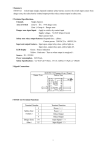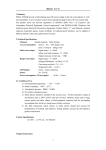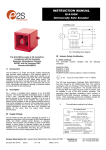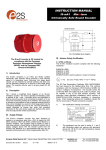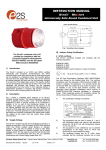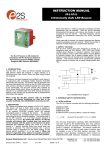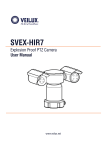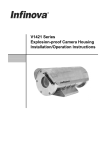Download STS49 User Manual
Transcript
BB0.467.012-10 1 Summary STS49 isolates and transfers 4~20mA of two-way safety zone controller, drivers two electrical converters, electric valve positioner or any two other loads of not more than 750Ω in two-way danger zone 2 Technical Specifications: Channel Double channels,Fully floating Area of load Zone 0,ⅡC,T4-6 danger zone Zone 1, Group A,Danger zone Safety zone input Signal range:4~20mA Danger zone output Maximum load resistance:750Ω Output resistance:>1MΩ Conversion precision(%) :0.2 Temperature drift:<1μA/℃ LED display Green:Source indication Source (20~35)VDC Power consumption(20 mA signal)at 24V,95mA 2.1 Condition of Use a) Environmental temperature:-10℃~+50℃ b) Relative humidity:<90%(25℃) c) Atmospheric pressure:80kPa~110kPa d) No explosive dangerous gases e) Safety Barrier should be installed in the security zone,Um-the maximum voltage of non-intrinsic side is 250V AC/DC and may not have vibration, shock, and no large current sparks and other effects of electromagnetic induction and the surrounding environment does not have a strong sense of place corrosion f) The field instruments which connect to safety barrier should have passed the identification of National Anti-explosive Testing Institute and got the anti-explosive product certification 3 Safety specifications Uo=28V, Io=93 mA,Po=660mW 4 Signal Connections 1 BB0.467.012-10 5 STS49 Terminal Functions Terminal Safety Zone Function Terminal Danger Zone Function 1 2 3 4 5 6 7 8 Input +V(ch1) Input -V(ch1) Input +V(ch2) Input -V(ch2) Power +V Power -V Empty Empty 9 10 11 12 13 14 15 16 Empty Empty Empty Empty Output +V(ch1) Output -V(ch1) Output +V(ch2) Output -V(ch2) 4 3 2 1 9 10 11 12 13 14 15 16 8 7 6 5 112 6 Dimensions 7 Installations 7.1 Guideway:Isolate barrier is installed on the standard international generic M35 Guideway. 7.2 Terminal lead:Rubber insulated cables,cable insulation strength should be above AC500V, traverse number of lead should not less than30,and cross-section area greater than 0.75mm2 7.3 Installation notes a) Isolate barrier should be put in a safe place to ensure the cleaning and no corrosive gas. b) The circuit wiring of intrinsic ends (blue) and non-intrinsic ends (yellow) of the isolate barrier is prohibited from wrong and confusion. The intrinsic safe leads should use the blue as the marking; intrinsic leads and non-intrinsic leads should be installed separately in the leads slot, and use different casing tubes. The intrinsic safety side of isolate barrier is not allowed to have a mixture of other power, including other power supply with intrinsic safety current. 2 BB0.467.012-10 c) When the isolate barriers are with concentrated layout, it should make the intrinsic side adjacent with the intrinsic side and non-intrinsic side adjacent with the non-intrinsic side to avoid the confusion. d) On the separate power supply debugging of isolate barrier, it is important to pay attention to the model, power polarity, voltage grading and connector tab on the shell of isolate barriers. e) It is forbidden to test the insulation between the terminals of isolate barrier with insulation ohmmeter, to check the insulation of the system lines, it should disconnect all isolate barriers at first, otherwise it would cause the fuse of internal instant fuse. f) If the internal module of isolate barrier is damaged and needs replacement, it is needed to return to the factory for repairing. The repaired isolate barriers should have a comprehensive re-examination before being put into operation. g) The installation, use and maintenance of isolate barrier should strictly abide by the relevant contents of GB3836.15-2000 “Part 15 of Explosive Gas Electrical Equipment: Dangerous place electrical installation (except mine)”, GB50058-1992 “Electrical Equipment design code of Explosion and Fire Risk Environment” and product brochures. 8 Package and Storage 8.1 Isolate barriers should be packed with transparent plastic bags and put in the special packing boxes. 8.2 Isolate barriers should be stored in a ventilation indoor environment with ambient temperature of 5-40℃ and relative humidity less than 85%, and without corrosive gases in the air. 8.3 Attachment A copy of product brochure A copy of product certification 9 Warranty The normal product warranty period is 18 months, the damage caused by improper use is not within the scope of warranty. 3




